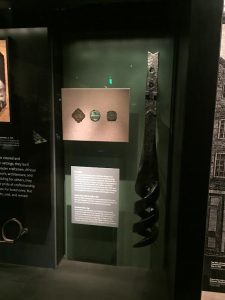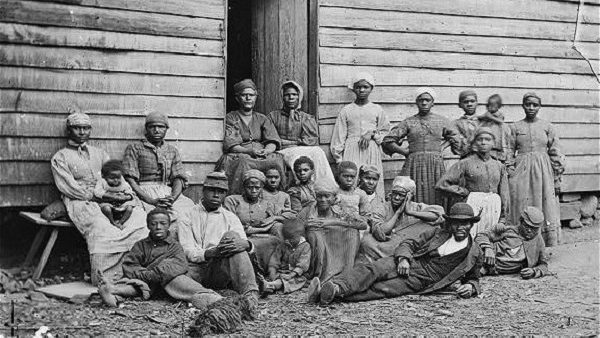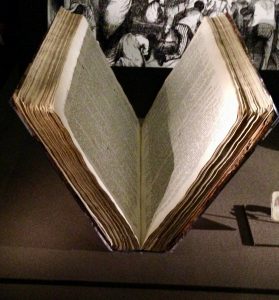Blacksmith Drillbit by Yubelka Nunez






The leather-bound Pulpit bible of Rev. James W.C. Pennington—which derived from a church established in 1819 in Hartford Connecticut, is more than just a bible; it is a symbol. Although, it symbolizes the importance and the role of Christianity during the Antebellum period (1821-1860), this bible tells a story about a great figure in African American history. Pennington’s bible is a symbol of the obstacles he overcame; going from slavery to freedom, educating himself, and the role he played in fighting for the rights of the free and the enslaved.
In 1840, Pennington became a pastor of the then Talcott Street Congregational Church—now known as the Faith Congregational Church, which also became a school and place for abolitionists to rally(Close). It was the first African American church in Connecticut, and it later became an anti-slavery institution, where it focused its efforts in participating in matters regarding slavery. Pennington and his congregation were active in the Amistad case—this case was about the enslaved Africans, who went to Connecticut for trial after they overthrew their captors aboard the Amistad in 1839; Pennington used his position and in some cases this very bible to encourage and support others, fight for the enslaved and rally for those who couldn’t. These are only a few of so many things that are tantamount to the importance of the bible in relation to this man; Rev. James W.C. Pennington.
Before Pennington became one of the most influential pastors of his time, he had to flee his past circumstance to embrace the future. James W.C. Pennington—originally known as Jim Pembroke, was born into slavery in the state of Maryland in 1807. After experiencing first hand, as well as witnessing the tyranny of slavery throughout his life; he decided to flee his plantation—when he was between the ages of 19-21, leaving his parents and his 11 siblings behind to pursue freedom in Pennsylvania. After escaping, he encountered a Christian woman who initiated his relationship with a family of Quaker abolitionists named William and Phoebe Wright in the state of Pennsylvania(Cummings). They not only taught him how to read and write, but they inspired his pursuit to Christianity, which then lead to him educating himself further by taking classes at Yale. He then moved from Pennsylvania to New York, which thereafter he settled in Connecticut.
Pennington like many ministers of his time, were active members in the abolition of slavery; they believed in the notion of paving the way for their fellow African Americans to be educated and free. Religion was very important, as it was the gate way to freedom, and accessing things and services that weren’t available before, due to slavery or segregation. The churches provided a safe-haven for African American school children and a common ground for abolitionists to meet and stand in unity in fighting and helping each other gain freedom, whether for Pennington himself or family members enslaved in the south.
This unity explains the collaboration of the objects surround Pennington’s pulpit bible at The National Museum of African American History and Culture. From the image of a Sunday church gathering and a document in Arabic to a face vessel and spirit bundle—which had ties to African spiritual practices and an incorporation of Christianity and African tradition respectively; all items within the enclosed glass casing, symbolize the importance of religion to the African American People in gaining freedom. It gave them hope to keep fighting and a cause for justice; it gave them a place to unify and a place to learn. These items are more than artifacts, they are symbols that signify the road to freedom and the struggles they had to overcome to get there. This demonstrates the resilience of religion, despite the opposition faced along the way; like the pages of this bible—which show signs of withstanding the test of time, so is the African American culture, which has endured and risen above the hardship and pain of oppression and slavery. These items signify African American history, which in its totality, enriches American history.
Bibliography
Close, Stacy. “Reverend James Pennington: A Voice for Freedom.” ConnecticutHistoryorg. Connecticut Explored, n.d. Web. 17 May 2017.
Cummings, Michael. “In the shadows no more: Divinity School honors Minister James W.C. Pennington.” Yale News. Yale University, 30 Sept. 2016. Web. 17 May 2017.

Found in the tropical Maldives of the Indian Ocean, cowrie shells were the primary and prized form of currency used earliest in China and later used in Africa for before gaining prominence throughout Europe and the Middle East. These small sea shells had an intercontinental power in trading, buying, and selling goods and services. They were a staple in the global economy, especially in Ancient Africa during the 15th and 16th centuries. In this essay, I will explain the prominent use of cowrie shells in West Africa, how European slave traders used this currency to buy African people to ship to the New World for slave labor, and the spiritual significance cowries had for African faith.
Cowrie are small, glossily polished, three dimensional shells with a light beige color. They have open ridges vertically lining the middle. The shells are oval and smooth with the middle ridges that split the shell being slightly rough. They feel cold and durable with a light weight individually though that when in mass would be heavy to carry and trade.

In Europe, cowrie trade began in the 15th and 16th centuries and was (primarily) dominated primarily by the Portuguese however by the 17th and 18th centuries, thereafter, promoted the use of cowries through significant trade in Africa, this increase in currency having influenced the African economy greatly. When the Europeans entered Africa, they faced empires and advanced clan leaders skilled in trade and negotiation. West Africa and these European countries began trading equally. Europe relied heavily on these affairs especially because they had a strong interest in gaining access to spices, textiles, precious metals, and salt.
Following foundational trading, Cowries were used in the economy to buy and sell inanimate goods and services until the 15th century when the colonies required labor to build new societies in the Americas. The dates the European countries ended their prominence in cowrie shell trade corresponds with their decline and termination of slave trading. The Dutch dominated until 1750 with their decline in slave trade occurring from 1780 to 1815. In 1814, the Netherlands signed an international agreement to end slave trading. It was after 1750 that the British became the main carriers of cowrie trade with Western Africa until 1807 which marked the end of their role in slave trading.

From the 1500s to the 1800s — the time the Portuguese, Dutch, and British dominated the cowrie market — Europeans shipped over twelve million Black slaves from Africa to America. This proves, Europeans used this currency to enter the West African market and exploit Africans, degrading them to slave labor. In the National Museum of African American History and Culture the cowrie shells were placed next to display text explaining Portugal, England, and the Netherlands’ role in the Atlantic Slave trade starting from “Trade Among Equals” to the commodification of Africans as the products cowrie shells bought. These shells were invaluable to Europeans as they boosted the economy and development of the American colonies. In this way cowrie shells are a key to African American history as a symbol of the beginning of the enslavement of their ancestors.

While these shells were a currency essential in building the European and American slavery economies, to Africans cowries had more meaning than wealth and enslavement. Physically they represented wealth, honor, and style. Spiritually, they symbolized a strong connection to the ocean spirits and Goddess protection. Cowries were also thought to be the mouth of Orishas in the Yoruba religion. It is no surprise that these shells were brought to the Americas to serve as talismans against enslavement.
Bibliography
“The Meaning and History of the Cowrie Shell.” Cowrie Shells, Cowry Shells: The Meaning and History | Africa Imports. African Imports, n.d. Web. 11 Apr. 2017.
Hogendorn, Jan, and Marion Johnson. “The Cowrie.” The Shell Money of the Slave Trade (n.d.): 5-19. Web. 11 Apr. 2017.
“Dutch Involvement in the Transatlantic Slave Trade and Abolition.” African Studies Centre Leiden. Centre Leiden, 24 Jun. 2013 Web. 11 Apr. 2017.
Kleinfeldt, Rich Kleinfeldt, and Sarah Long. “By 1750, Almost One in Four People in the Colonies Were Slaves.” Many Things. N.p., n.d. Web. 11 Apr. 2017.
“Cowry Shells, a Trade Currency.” Cowry Shells, a Trade Currency — Museum of the National Bank of Belgium. Museum of the National Bank of Belgium, n.d. Web. 11 Apr. 2017.
“1863 Abolition of Slavery – Timeline Dutch History.” Rijksmuseum. RIJKS Museum, n.d. Web. 11 Apr. 2017.
“NMAAHC Collections Search.” National Museum of African American History and Culture. N.p., n.d. Web. 11 Apr. 2017.
Sarah Perez, Liberal Arts
I have always enjoyed history, specifically American History. I have always felt in middle/high school that teachers weren’t giving us the full story of historical events. When it comes to African American history I feel American history would not be fulfilled with out the knowledge of slavery and activism of African Americans in this nation.
Santana Alvarado, Sociology
African American history was helped my understanding of this society and how our imperialist white supremacist patriarchal capitalist system came to be, which helps me to more fully critically think of ways to combat the oppression rampant against Black communities across the nation and around world. African American history tells the history of people who are full of spirit, struggle, and commitment to life giving liberation and love. It has been a course that empowers me and broadens my understanding and perspective.
Lydia Cunningham, Liberal Arts
Being an African American herself, she feels that this class is not only relevant to the times but essential in learning about African American history.

The Point Pines Plantation had become a valuable source for Sea Island cotton By 1850, Sea Island cotton was grown in the coastal eras in the states of South Carolina and Georgia. In the 19th century, southern economy had grown and resulted on the demand of slave labor plantations to increase. By 1850, the south became the Cotton kingdom, cotton had become a valuable crop. Unlike other crops like sugar and tobacco, cotton was a simple crop, slaves were able to produce a wide amount. The Point Pines Slave Cabin is a historical reminder and reason for American economy flourishing, while becoming a main source of cotton around the nation and the world. With the southern states booming with financial success, the northern states used cotton growth to their industrial advantage. The population of enslaved African Americans was at its highest. During this time anti-slavery activist known as the abolitionist fought for slavery to be abolished. With the westward expansion debate of the new states becoming free, slave states developed conflict between southern slave holders and anti-slavery northerners.
The Cotton Kingdom, the demand for slaves in the Deep South to work in cotton plantations had increased. This had been the effect of the cotton belt, many slaves were sold to work on cotton plantation inland. In the point Pines Plantation Charles Bailey was the slave owner, a slave named Hannah Chapman witnessed this issue as her father was sold away from her to work in plantation in the Deep South. Enslaved African Americans in Edisto Island developed strong roots of love and togetherness. In the Cabin they found ways to come together, care for on another’s children and support each other. The success of cotton plantations encouraged the south to move their slave economy westward. As news of slavery moving west ward started, abolitionist were against the practice of slavery. By mid- 19th century tension between north and south on slavery broke out into a civil war in 1861. At the end of the war in 1865, the south had lost the fight. The work towards freedom started with the Emancipation Proclamation signed my President Abraham Lincoln two years before the end of the war, granting enslaved Africans their freedom, unfortunately this did not apply for all enslaved African American. The Emancipation Proclamation only applied to southern states that did not break away from the North, South Carolina was the first state to secede from the union, leaving the enslaved African Americans slaves in Edisto Island to remain in slavery. A new era had begun after the war, reconstruction of the whole nation was on its way. In 1865 slavery had been abolished throughout the nation. Many African Americans in the south were given land to start their own crops, this was considered share cropping. While many stayed to work on their formal masters plantations for wages to soon buy their own land. In the Point Pines plantation, former slaves were given the land from their master Charles Bailey. For many years African Americans have lived in the cabin from generation to generation. The cabin had been a place for them to be trapped and treated like property to a place where they raised their children as free people.
The importance of bringing the Point Pines slave cabin to the national museum of African American history and culture was to share a period in were slavery was crucial to American society. This three dimensional object would attract the eyes of many people as it represented African Americans contribution as the back bones to the financial stability of America. It’s important to state that the cabin was not behind glass windows like many of the other objects. It’s believed it was shown outside in the open to send a message that African American history is therefore American History. Also the exhibits before it were dark, lights were dim giving a sense of sadness leading to the slave cabin. The cabin was small when observing, the southern weather would have been stifling making it difficult for a human being to live in. The cabin had only one window, oxidized parts of it had fallen apart and considering that it was handmade. Surrounding the cabin was a cotton gin, which related back to the historical context of the cabin, as it once helped support the south’s cotton kingdom. Enslaved Africans led success of the south, although it was unfair it is true. The cabin symbolizes the working progress to freedom and equal rights of African Americans, as their contributions have been forgotten in history.

Work Cited
“Edisto Museum.” Edisto Museum RSS. N.p., n.d. Web. 17 May 2017.
“The Edisto Island Slave Cabin, Communities, and Collecting.” National Museum of African American History and Culture. N.p., 03 Oct. 2016. Web. 17 May 2017.